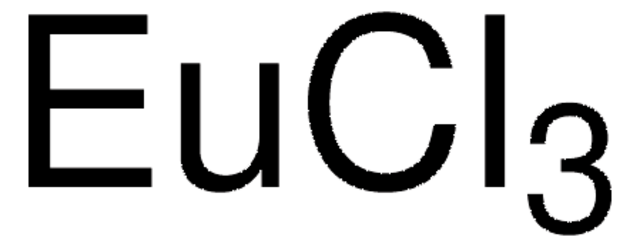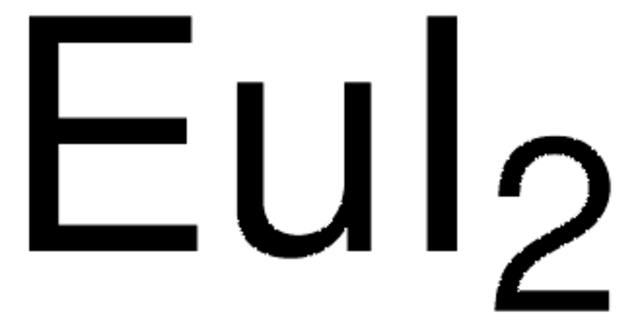431850
Europium(II) chloride
99.99% trace metals basis
Sinónimos:
Dichloroeuropium, Europium chloride, Europous chloride
About This Item
Productos recomendados
Análisis
99.99% trace metals basis
formulario
powder and chunks
idoneidad de la reacción
reagent type: catalyst
core: europium
impurezas
<0.1% Zn
cadena SMILES
Cl[Eu]Cl
InChI
1S/2ClH.Eu/h2*1H;/q;;+2/p-2
Clave InChI
BMANZYKPCBPZFG-UHFFFAOYSA-L
Descripción general
Aplicación
- A dopant to prepare phosphor materials for energy-efficient solid-state lighting.
- A pressure-sensor material.
- A suitable precursor for the synthesis of Europium(ii) compounds coordination polymers with 2,2′-bipyrimidine-mediated ferromagnetic interactions.
Para utilizar con
Código de clase de almacenamiento
11 - Combustible Solids
Clase de riesgo para el agua (WGK)
WGK 3
Punto de inflamabilidad (°F)
Not applicable
Punto de inflamabilidad (°C)
Not applicable
Equipo de protección personal
Eyeshields, Gloves, type N95 (US)
Certificados de análisis (COA)
Busque Certificados de análisis (COA) introduciendo el número de lote del producto. Los números de lote se encuentran en la etiqueta del producto después de las palabras «Lot» o «Batch»
¿Ya tiene este producto?
Encuentre la documentación para los productos que ha comprado recientemente en la Biblioteca de documentos.
Artículos
Thermoelectric Performance of Perovskite-type Oxide Materials
The prevailing strategies for heat and electric-power production that rely on fossil and fission fuels are having a negative impact on the environment and on our living conditions.
The rare earth elements impact nearly everyone in the world. All of the people living in advanced technological countries and almost all those living in third world countries utilize the rare earths in their everyday living—the car that one drives (gasoline is refined from oil using rare earth catalysts and catalytic converters reduce the polluting emissions from the automotive exhaust), watching the news on TV (the red and green colors in TV screens), the telephones and computers we use to communicate (the permanent magnets in speakers and disc drives), just to name a few examples.
Nuestro equipo de científicos tiene experiencia en todas las áreas de investigación: Ciencias de la vida, Ciencia de los materiales, Síntesis química, Cromatografía, Analítica y muchas otras.
Póngase en contacto con el Servicio técnico




